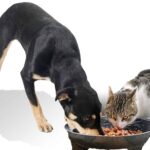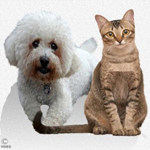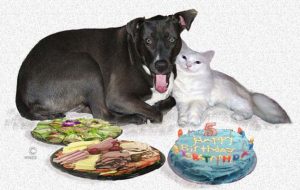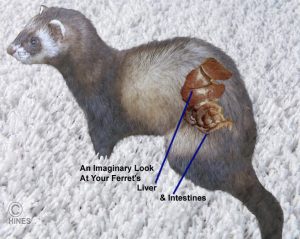Why Does My Dog Or Cat Have Diarrhea?
Ron Hines DVM PhD



Do not give reformulated kaopectate with bismuth subsalicylate to cats.
This article gives a general outline of how your veterinarian might go about discovering the cause of diarrhea in your pet and some of the ways they might treat it. Not every cause of diarrhea, test or medication is covered – but many of the most important ones are. Many of my links to other articles go into greater detail.
Why Does Diarrhea Occur?
Anything that inflames or irritates the lining of your pet’s intestine can cause diarrhea. When your pet’s body senses that something is in its intestine that shouldn’t be there, it tries to get it out as rapidly as possible. If it is high in your pet’s digestive tract it will vomit. If it is lower in the tract it will come out as diarrhea.
How Might My Veterinarian Finds The Cause Of This Problem?
I am always delighted when a client actually brings me a sample of the mess that their pet has made. In more than half the cases, the diagnosis can be made from that fecal specimen and the pet’s history alone. Try to bring your vet a fresh specimen – no need for more than a few tablespoons full to examine under the microscope. But when one is searching for foreign objects the pet may have grazed on, I usually sift a much larger quantity through a sieve.
Because our patients can’t talk, the history that you provide to your veterinarian is extremely important. That is why it is important that the person who knows the pet best accompanies it to the vet’s office. The first question often asked is whether this is a sudden acute problem or if it is chronic and has been going on quite a while. The next thing often asked is if you fed something unusual to the pet or if torn remnants of some household object were strewn about the house. Pets get bored, pets get anxious. When they do, they often eat inappropriate things.
Is This A High Intestinal Problem Or A Low Intestinal Problem?
First we need to get a general idea as to what part of your pet’s intestine is inflamed or has been irritated. Cases of diarrhea fall into two general groups in approximately equal numbers. In the first group, the problem is in the small intestine (the higher portion closer to the stomach where most food nutrients are absorbed). In the second group hypermotility of the large intestine (colon) is expelling feces before enough water has been extracted. High diarrheas tend to pose the most acute danger. Sometimes, the problem is a combination of both types.
When the problem is high in the small intestine your pet is likely to eliminate large amounts of stool, but the frequency of its bowl movements will not have increased that much. If there is blood in this stool, it will be chocolate-colored, not bright red. That is because enzymes in the digestive tract have had time to digest the blood. There won’t be much straining when those pets defecate. The stool in cases of high diarrhea is not thick, sticky or mucoid. Mucus is generally a sign of a lower irritation in the colon. Vomiting may also accompany high small intestinal problems. Your pet may also have a tummy ache.
In the group of pets with lower intestinal problems, eliminations tend to be uncomfortable and urgent. When they go, the amount of stool is small and often covered with a mucus film. They tend to take a long time to poop and try several times. If the colon is inflamed enough, the stool may be coated with flecks of bright red or rust-colored blood. Pets that have eaten bones, sharp or gritty objects can have a mixture of diarrhea and constipation. The material passed is a combination of hard lumps and soft or watery stool. These pets often need laxatives or enemas to clean their digestive tract out.
Dehydration:
This is the most serious complication of severe diarrhea. Severe diarrhea is most serious in very young, very old and very small pets. They can become severely dehydrated very quickly. Dehydration in small pets and frail elderly animals can be fatal because their surface area is large in proportion to their body weight. As dehydration progresses these pets have trouble maintaining their body temperature and may lapse into coma. Only the rapid infusion of intravenous fluid will save them.
When the problem is minor, giving fluids such as Pedialyte™ is sufficient. When the dehydration is severe, the pet needs to be hospitalized and the fluids given by intravenous drip.
Body Temperature:
The body temperature of your dog or cat should be about 101.5 F (38.6 C). In some cases of severe diarrhea and dehydration, their temperature will drop below 100 F (37.8 C). These pets need to be warmed. In fewer cases, their body temperature will go above 102. 6. F (39 C). These pets need to be cooled – or they need to receive medications to lower their body temperature. You can read about proper body temperature in dogs and cats here.
What Complications Might Occur?
Intestinal inflammation in young pets with diarrhea occasionally causes the intestines to thrash about so vigorously that the intestines tie themselves in knots (volvulus) or fold in upon themselves (intussusception). Both these conditions can be life-threatening.
What Non-Specific Treatment Are Available To Me At Home When This Is A Minor Problem?
Diarrheas in dogs and cats that were caused by eating the wrong foods or transient stress often improve if you withhold food for 24 hours, confine the pet and perhaps give it an over-the-counter pet diarrhea remedy. These patent remedies (like kaopectate) are rarely required. The problem is that these transient, mild diarrhea cases can look quite the same as the early stages of considerably more serious cases. If your pet has had multiple cases of transient, mild diarrhea, you may have the confidence to make that decision yourself. But it is always safer to consult your veterinarian.
Diarrhea that contain blood, persists more than 24 hours or affect your pet’s general activity and perkiness needs the immediate attention of a veterinarian. So does diarrhea that rapidly dehydrates your pet. So does diarrhea in pets with other health issues. It is also more dangerous in the very young and the very old. When you visit your veterinarian, be sure to bring along several tablespoons full of the pet’s stool in a sealed baggie. I know this is an unpleasant task. But I often find the cause of the problem right away by passing the stool through a sieve or examining it under a microscope. Your veterinarian may be able to obtain a stool specimen directly from your pet, but it might not be enough for all the examinations that should be done. Wash your hands well – because some of the infectious causes of diarrhea can affect you too.
Checking Your Pet’s Stool Specimen:
Depending on the history you give about your pet’s lifestyle, I often pass the material you brought through a kitchen strainer to hunt for objects such as chicken bone fragments, leaves, sticks, bug parts, glass, sand, Christmas tinsel, aluminum foil, etc. that are the source of the problem. Over the years, I have found every imaginable thing. In cats, sewing thread (sometimes with the needle still attached) is a common discovery.
Vets or their technicians then prepare slides of the material to examine under the microscope. Some of these cases show a normal digestive process where food is being digested and absorbed. In others, fat globules are present, and protein particles are sharp – evidence of poor digestion. These are either cases of maldigestion or malabsorption. They can be due to a hypermotile intestine or the lack of normal liver and pancreatic enzymes. Some stool is abnormally light in color due to a lack of these enzymes. This can be a hint of liver, pancreatic or gall bladder disease. Other times common intestinal parasites or their eggs are visible under the microscope.
What Are Some Of The Most Common Causes Of Diarrhea?
Pet Food Quality And Constituents
Buying that marked-down, generic brand of dog or cat chow instead of your regular name brand is a very common cause of diarrhea. Actually, any time you switch brands of food, a period of diarrhea is apt to occur. Quality costs money – when you go below a certain price, the quality of the ingredients suffer. The words “High Protein” mean very little. Feathers, hooves and beaks are all protein. But they are not digestible protein, and they will cause diarrhea. Once you find a brand of food your pet likes and does well on, stay with that one brand. Pets rarely if ever become “bored” with a quality food. Little companies that market their products through specialty stores have a hard time screening their ingredients or producing a product that does not vary from batch to batch. So, I generally suggest you feed your dog and cat a diet produced by a large company that makes other products that you trust – not one sold by your groomer, only online or by some other niche marketer.
Overeating
Some dogs and many cats over-eat when they are fed just once a day. This can result in diarrhea, colic and vomiting. I suggest feeding dogs and cat with this problem three times a day or leaving the food where they can munch whenever they please. Just don’t let them become over weigh like these two.
Foods That Don’t Agree With Your Pet
Some pets are intolerant to certain ingredients in pet foods. This can be beef, liver or chicken, preservatives, dyes and the like. Very few pets are actually allergic to pet food ingredients. You can try a diet made with different ingredients, or you can make your own at home. (read here)
Stress
Some pets – toy dogs, nervous cats and ferrets in particular – vent their stress through their intestines. This can take the form of vomiting, refusal to eat, diarrhea or blood in the stool. After this occurs several times, owners usually draw the connection between events that upset the pet and bouts of diarrhea. These pets should be checked to be sure they are not suffering from Addison’s Disease.
Dietary Indiscretions
The most common cause of diarrhea in dogs and ferrets (not so much in cats) is dietary indiscretions – the eating of garbage, grass, plant leaves, etc.
It is amazing the things pets will eat! Many of these cases are actually separation anxiety cases where a panicky pet eats everything in sight. Placing these pets on a large dose of petrolatum-based cat laxative may help slide this material out with the stool. These pets need to be monitored carefully for seventy-two hours to be sure the intestine does not block. And they need to be confined in an area that can be easily cleaned up. I sometimes feed them art glitter and wait for it to come out the other end. At the first sign of abdominal distress, depression, general weakness, fever or blood in vomitus or stool, they should be rushed to a veterinarian for further testing. They also need immediate veterinary care if you suspect that they ate something dangerous or sharp.
Diarrhea Caused By Medications And Chemicals:
Antibiotics
Many antibiotics and sulfas kill the normal, helpful bacteria in the pet’s intestine as well as the dangerous ones. There was a time when neither veterinarians nor physicians understood the importance of a healthy, diverse microbiome. We do now. When the normal bacterial flora of the intestine is destroyed diarrhea may result. This problem can occur with injected antibiotics as well as oral ones. Giving your pet yogurt or bacterial gel pastes, decreasing the antibiotic dose, or changing to a different antibiotic might all be helpful. But do not do any of those things without your veterinarian’s knowledge.
Other Drugs From The Pharmacy As A Cause:
Many medications that we dispense to your pet can cause diarrhea. Thyroid medication, NSAID drugs such as Rimadyl® and aspirin, worming medications, and topical insecticides are only a few of the many medications that can be responsible. Some pets are just sensitive to a particular medication or need a lower or less frequent dose. Others do better when a smaller dose of the medication is given – but more frequently.
Diarrhea Caused By Parasites:
Intestinal Worms:
Hookworms, roundworms, whipworms and strongyloides are some of the nematode parasites that cause diarrhea in dogs and cats. Read about them in dogs here, in cats here. These organisms are the most common causes of diarrhea in puppies and kittens. They are also a threat to children who are accidentally exposed to your pet’s stool. You can read about these parasites and how I deal with them in other articles on my website. If there are enough parasites to cause diarrhea, their eggs or larva are usually seen when the stool is examined with a microscope.
Protozoan Parasites:
Some protozoal parasites are single-celled microscopic parasites of the intestine. Diarrhea is their primary sign. This group includes coccidia and giardia. We treat them with bland diets, sulfonamides and metronidazole. Giardia can cause similar problems in pet owners – particularly children.
When diarrhea persists in your cat, despite giving worming medications, metronidazole and probiotics, the cat should be examined for Tritrichomonas foetus. This is particularly so if the cat was obtained from a shelter, group home, cattery or if what was thought to be a giardia or coccidiosis problem fails to respond to the usual medications. You can read more about Tritrichomonas in cats here. Diagnosing this problem requires a specific test (PCR, or InPouch tests) and a specific medication (ronidazole). You can read more about those procedures here. Tritrichomonas can cause similar issues in cats. (read here)
Diarrhea Caused By Viral Infections:
Parvovirus Of Dogs
Parvovirus infection of dogs causes severe foul-smelling diarrhea. Mature dogs recover after a period of diarrhea, but the disease is often fatal in young unvaccinated pups or very small breeds. Parvovirus attacks the lining of the small intestine causing bloody diarrhea and vomiting. Dogs are severely depressed, dehydrated and in much pain. These pets die from fluid loss and shock, so most of my efforts aim at replacing these fluids. Parvo-infected dogs cannot keep oral fluids and medicines down, so I give our fluids and medications by injection. vaccinate puppies against. Read about parvovirus of dogs here.
Panleukopenia Of Cats
This is another parvovirus that can cause similar symptoms to parvovirus in dogs. Read about feline panleukopenia in cats here.
Coronavirus Of Cats
Feline enteric Coronavirus is highly contagious among cats but rarely fatal. The virus is shed in the feces of carrier cats causing erosion of the lining of the intestine. Recently weaned kitten have fever, vomiting and diarrhea that lasts 2-5 days. They lose their appetite. I treat them with fluids, antibiotics and medications to slow the diarrhea. This virus is widely dispersed among the domestic cat population of the world. It is the same virus that occasionally mutates into FIP.
Diarrhea Caused By Bacterial Infections:
Spoiled Food – Food Poisoning
Spoiled food is often contaminated with toxins and bacteria that cause pets to have diarrhea and vomit. Food poisoning usually resolves itself after diarrhea purges the contaminated material from pet’s the body. That is why it is unwise to give these pets medications that prevent that diarrhea because that traps harmful bacteria and their toxins within the body. Just be sure the pet stays well hydrated to make up for the water lost to vomiting and diarrhea. The treatments for spoiled food and for eating toxic products are quite different. Two bacteria that are commonly involved in these cases are staphylococcus and Escherichia coli (E. coli). Dehydration is the most serious side effect of diarrhea and vomiting. Infant animals can quickly go into shock from dehydration. Threateningly low body temperature is also common in these infant animals. Products such as Pedialyte™ are excellent for preventing or correcting mild dehydration. But intravenous or subcutaneous fluids administered by your veterinarian can save the day when dehydration is severe.
Salmonella And Campylobacter In Dogs And Cats
Feeding poorly cooked meat products and chicken pass these bacteria to pets and humans. As with food poisonings, keeping the pet well hydrated is extremely important. In catteries, adult cats carrying salmonella often pass it to their kittens with sometimes fatal results. It can be quite difficult to get Salmonella out of a group of cats once the bacteria have become established in a cattery or cat colony. Batryl (enrofloxacin) has been an excellent drug to use in adult pets with diarrhea, but it must be used with caution in growing animals. Salmonella and campylobacter are my chief concern in feeding RAW diets to your dog or cat. That is why I do not recommend them. Read about salmonella in pets here. Read about raw diets here.
Diarrhea In Cats Caused By Bartonella:
An organism call Bartonella has been implicated in chronic gastrointestinal infections in cats and occasionally dogs. Until recently, Bartonella was primarily associated with Cat Scratch Fever. The diagnosis of Bartonella infection is made using sensitive laboratory tests. When cats or dogs are positive for this organism it can usually be successfully treated using azithromycin, doxycycline or rifampin or a combination of them. Bartonella is spread by fleas.
Acute Gastroenteritis of Ferrets
Several bacteria cause infections of the gastrointestinal tract of ferrets that appear as bloody diarrhea, vomiting and dehydration. Stress is often the precipitating factor in these conditions. Ferrets that vomit and pass fluid stools rapidly dehydrate. Dehydration can be fatal in these pets. The first thing I do is give the ferrets large doses of intravenous and subcutaneous fluid. (5% dextrose). I place them on injectable antibiotics, keep them warm and withhold all food and oral liquids. Bacteria most often associated with this problem are salmonella, helicobacter and campylobacter. Because diarrhea and vomission remove these bacteria and their toxins from the body I rarely attempt to lessen them. Instead, I replace the fluids and nutrients, as they are lost.
Poorly Understood Causes (Idiopathic causes):
Inflammatory Bowel Disease (IBD)
Dogs and cats sometimes develop intestinal inflammations, diarrhea and vomiting for causes that are not always clear. For more information on Inflammatory Bowel Disease in your dog, go here. For more information on Inflammatory Bowel Disease in your cat, go here.
Hemorrhagic Gastroenteritis Of Dogs
Toy breeds of dogs are susceptible to bloody diarrhea the cause of which remains unknown. No doubt many of these cases fall into other groups I have mentioned but were not diagnosed. Many of these cases were probably due to stress or stress was a compounding factor. Some emotional dogs exhibit stress through their intestines. In other dogs, the problem is probably undiagnosed Addison’s disease in which the body is deficient in cortisone production. Most of these cases respond well to IV fluids, food deprivation for 24-48 hours and then a gradual increasing amounts of bland diet fed. Many vets give these cases the oral corticosteroids, prednisolone or prednisone and place them on the metronidazole, sulfonamides or tylocin. These problems tend to reoccur in the pet from time to time. If they do reoccur, extensive blood tests are often required to get to the root cause of the problem.
Eosinophilic Enteritis Of Cats
This is sometimes considered a type of eosinophilic complex of cats. It shares a lot of characteristics with inflammatory bowel disease of cats (IBD). The signs of eosinophilic enteritis are diarrhea, weight loss and vomiting. Some veterinarians suspect the problem is due to food allergies, others believe flea bite allergies are a cause. Cats with this problem often have elevated numbers of white blood cells called eosinophils. These cells are associated with allergic conditions in pets and people. Sometimes the skin is ulcerated as well or ulcers are present on the lips, tongue, mouth and toes. The disease responds to injections and oral forms of corticosteroids such as methylprednisolone acetate (“Depo”). The human birth control medication, Depopovera® (medroxyprogesterone acetate) also seems to relieve the problem temporarily. Moving the cat to a different home or environment and/or feeding bland diets also help bring the disease into remission in other cats. I have also seen the skin and oral forms of this disease disappear when fleas were eliminated from the cat and its environment.
Lymphangiectasia Of Dogs
Sometimes called plasmacytic enteritis, this condition is diagnosed by a pathologist’s examination of snippets of the wall of the small intestine which are removed at surgery. Lymphangiectasia is an improperly formed intestinal lymphatic system, which results in protein being lost from the body (protein-loosing enteropathy). We think that in some cases the pets were born with this disease and in others they acquired it later in life. Most affected pets respond to a combination of bland diet and anti-inflammatory doses of corticosteroid drugs such as dexamethasone or prednisolone, but the disease is never completely cured. Diets you prepared at home can help. Read about them here. They should contain minimal amounts of fat with ample amounts of high-quality protein.
*************************
Inflammatory Bowel Disease of Ferrets
In this condition, the lining of the stomach and small intestine becomes inflamed and may also ulcerate. Some feel that this condition is a form of autoimmune disease – others that it is due to allergies to various ingredients in ferret diets (possibly chicken). Perhaps both can play a part. Ferrets with this condition pass frequent loose watery stools and may also vomit. They become very thin. Diagnosis of this condition is often made by elimination of other causes. Exact diagnosis can only be made from biopsies of the pet’s intestine, which may require surgery. Because the symptoms are quite similar to acute and chronic bacterial gastroenteritis of ferrets, stool samples need to be cultured for these bacteria. When these causes of similar disease have been eliminated, the ferrets usually improve on a regimen of amoxicillin, metronidazole (Flagyl®) and prednisolone. This disease is rarely cured, but it can be managed. I usually also put these pets on Pepto-Bismol® and Tagamet®. It is hard to put weight on them because food moves too rapidly through their intestines and much of the absorptive power of the intestinal lining has been lost. This is why additional vitamins help these pets.
During flare-ups, liquid diets such as AD® can be feed. Then, feeding one of the bland diets marketed for similar conditions in dogs and cats (i/d®, EN®, ZD®, etc.) often minimizes this problem. Bland diets marked for cats have sufficient protein, but those manufactured for dogs contain less than the optimal amount for ferrets. If dog products are used, I suggest that they be supplemented with vitamins, cooked egg whites and cottage cheese. Low intermittent oral doses of corticosteroids such as prednisone are also helpful.
You are on the Vetspace animal health website
Visiting the products that you see displayed on this website help pay the cost of keeping these articles on the Internet.




